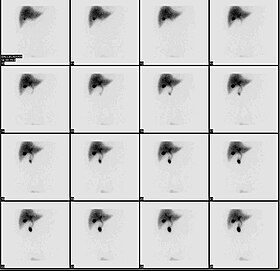Cholescintigraphy
| Cholescintigraphy | |
|---|---|
 Normal hepatobiliary scan (HIDA scan). The nuclear medicine hepatobiliary scan is clinically useful in the detection of the gallbladder disease. | |
| ICD-9-CM | 92.02 |
| OPS-301 code | 3-707.6 |
Cholescintigraphy or hepatobiliary scintigraphy is scintigraphy of the hepatobiliary tract, including the gallbladder and bile ducts. The image produced by this type of medical imaging, called a cholescintigram, is also known by other names depending on which radiotracer is used, such as HIDA scan, PIPIDA scan, DISIDA scan, or BrIDA scan.[1][2] Cholescintigraphic scanning is a nuclear medicine procedure to evaluate the health and function of the gallbladder and biliary system. A radioactive tracer is injected through any accessible vein and then allowed to circulate to the liver, where it is excreted into the bile ducts and stored by the gallbladder[3] until released into the duodenum.
Use of cholescintigraphic scans as a
Medical use
In the absence of gallbladder disease, the gallbladder is visualized within 1 hour of the injection of the radioactive tracer.[citation needed]
If the gallbladder is not visualized within 4 hours after the injection, this indicates either cholecystitis or cystic duct obstruction, such as by cholelithiasis (gallstone formation).[6]
Cholecystitis
The investigation is usually conducted after an
Cholescintigraphy for acute
Biliary dyskinesia
Cholescintigraphy is also used in diagnosis of the biliary dyskinesia.
Radiotracers
Most
| Nonproprietary drug name (USP format) | Common chemical name | Acronym | Comments |
|---|---|---|---|
| technetium Tc 99m lidofenin | hepatobiliary iminodiacetic acid;[12] dimethyl-iminodiacetic acid[10] | HIDA | An early and widely used tracer; not used as much anymore, as others have progressively replaced it,[13][6] but the term "HIDA scan" is sometimes used even when another tracer was involved, being treated as a catch-all synonym. |
| technetium Tc 99m iprofenin | paraisopropyl-iminodiacetic acid[10] | PIPIDA | |
| technetium Tc 99m disofenin | diisopropyl-iminodiacetic acid[10] | DISIDA | |
| technetium Tc 99m mebrofenin | trimethylbromo-iminodiaceticacid[12] | BrIDA | |
| diethyl-iminodiacetic acid[10] | EIDA | Seems to have been a laboratory tracer but never widely used clinically | |
| parabutyl-iminodiacetic acid[10] | PBIDA | Seems to have been a laboratory tracer but never widely used clinically | |
| BIDA[14] | Seems to have been a laboratory tracer but never widely used clinically | ||
| DIDA[14] | Seems to have been a laboratory tracer but never widely used clinically |
Etymology and pronunciation
The word cholescintigraphy (, most literally "bile + flash + recording".
References
- PMID 21861996.
- ISBN 9783319061115.
- ^ Michael, Picco, M.D. "HIDA scan (cholescintigraphy): Why is it performed?". Mayo Clinic. Retrieved 2007-12-11.
{{cite web}}: CS1 maint: multiple names: authors list (link) - ISBN 978-3-319-67066-9.
- S2CID 6118821.
- ^ PMID 21078782.
- PMID 7979854.
- ISBN 978-1-4419-7776-2. Retrieved 23 August 2012.
- ISBN 978-0-323-05407-2. Retrieved 23 August 2012.
- ^ S2CID 12260768.
- PMID 6897074.
- ^ a b Elsevier, Dorland's Illustrated Medical Dictionary, Elsevier.
- ISBN 978-3-642-00647-0.
- ^ PMID 24744445.
